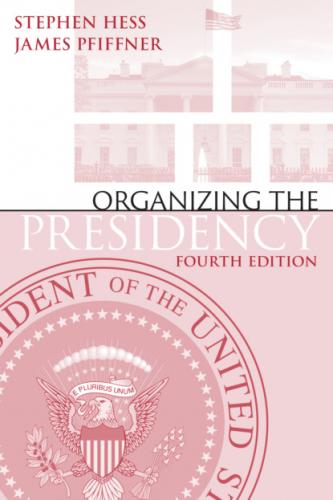Within the Executive Office, Eisenhower had an opportunity to kill off the Council of Economic Advisers in 1953. The Republican Congress, disenchanted with the politics and economics of Leon Keyserling, had drastically cut the CEA budget. But Gabriel Hauge convinced the president to keep the council and to hire Arthur Burns as its chairman. Under the 1946 enabling act, the three members of the council were to be coequal, but Eisenhower quickly won approval of a reorganization plan giving operating responsibility to the chairman, a variation of a Hoover Commission proposal. Burns chose his staff mostly from the academy rather than from government service. Although Adams feared that Eisenhower and Burns would not get along, his worry proved groundless. When the 1954 economic downturn began, Burns introduced regular briefings, often lasting thirty minutes, at the cabinet meetings, and according to Adams, “Eisenhower listened to him with fascination.”38 The CEA survived its first crucial transition in administrations because of the increased stake of the president in the behavior of the economy, because the council members and their staff were congenial to the president, and because they provided him with information he considered immediately useful.
The Bureau of the Budget, so important in the Truman administration, did not fare as well. Two of Eisenhower’s four budget directors were bankers and two were accountants, whereas their predecessors had had backgrounds in public administration.39 For instruction in management reorganization the president was more apt to look to the second Hoover Commission and to his Committee on Government Organization (Nelson Rockefeller, Arthur Flemming, and Milton Eisenhower). Otherwise the Budget Bureau continued to do about what it had always done, but it was not as central to the making of policy. This was caused less by suspicion of the career bureaucrat than by a simple law of physics: everyone could not occupy the same space. Eisenhower’s system of an expanded White House staff and a more powerful cabinet left less room at the center for the Budget Bureau to occupy.
The testing of Eisenhower’s staff-and-cabinet system came during his extended illnesses. The illnesses happened to coincide with periods of considerable calm in the nation and the world, for which the White House–cabinet arrangement could hardly take credit. But from Eisenhower’s viewpoint these periods proved that his organizational design would work as intended—efficiently, without friction, confidently. And this was his objective for his government and his country.
Dwight Eisenhower chose a way of organizing the presidency that was very different from that of his predecessors. His structured staff system increased the size of the White House, yet the White House was to continue to grow even when it returned to more fluid designs. However, as a result of his having asked for and received substantially increased appropriations from Congress for staff purposes, a new floor was established.
The emphasis on creating new staff mechanisms did not have an adverse effect on the efficiency of domestic operations but did become burdensome for conducting foreign relations. Eisenhower’s White House showed that a large staff need not be operational, at least if it is balanced with tenacious cabinet officials. Still, as future presidents would prove, the larger the staff, the greater the temptation to try to run the departments from the White House.
The use of the cabinet for collective advice was particularly suited to Eisenhower’s preferences for receiving information and was relatively frictionless because of the homogeneity of the members. The rudimentary cabinet secretariat, however, was less successful in forcing the most important decisions through the system.
The combination of an efficient and orderly White House staff and unusual reliance on the cabinet fit the president’s personal needs and limited objectives. The liabilities of the administration—the absence of a steady stream of creative proposals and the failure to recognize the boiling point of the civil rights issue and certain other domestic conditions—have been blamed on Eisenhower’s techniques of management. Could the same system that worked for an intrinsically conservative and nonactivist president be adapted to the needs of a liberal, activist one?
The proposition was not tested by Kennedy and Johnson, who simply assumed that it could not. Nixon was an activist, but while he favored a highly structured White House staff, he quickly rejected a collegial use of the cabinet, and, lacking Eisenhower’s skill in the art of using staff, his methods turned out to be more a perversion than an extension of the Eisenhower system.
In the wake of Eisenhower, conservative results and a structured staff system were often equated by social scientists who may have been personally uncomfortable with such systems and unfamiliar with how they operate. It is hardly surprising that they would propose methods of organization that seemed more congenial to them. Yet there is no evidence to prove that Eisenhower’s system was ineffective. Certainly, imaginative people prefer to work within systems of least constraint. It is unlikely, however, that a liberal president with liberal personnel would produce a conservative administration even if the presidency were organized along more structured lines.
Конец ознакомительного фрагмента.
Текст предоставлен ООО «ЛитРес».
Прочитайте эту книгу целиком, купив полную легальную версию на ЛитРес.
Безопасно оплатить книгу можно банковской картой Visa, MasterCard, Maestro, со счета мобильного телефона, с платежного терминала, в салоне МТС или Связной, через PayPal, WebMoney, Яндекс.Деньги, QIWI Кошелек, бонусными картами или другим удобным Вам способом.
